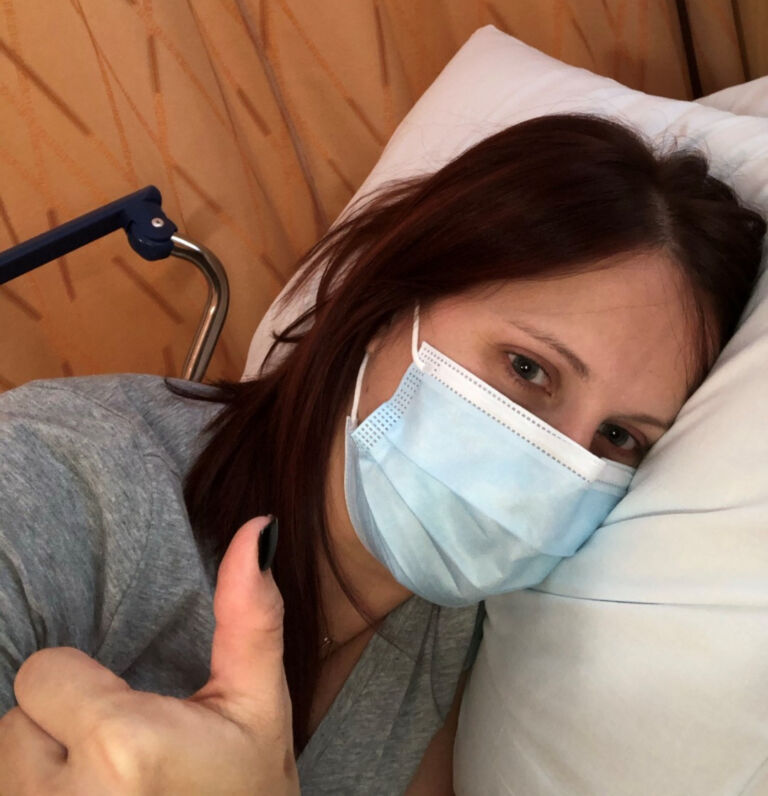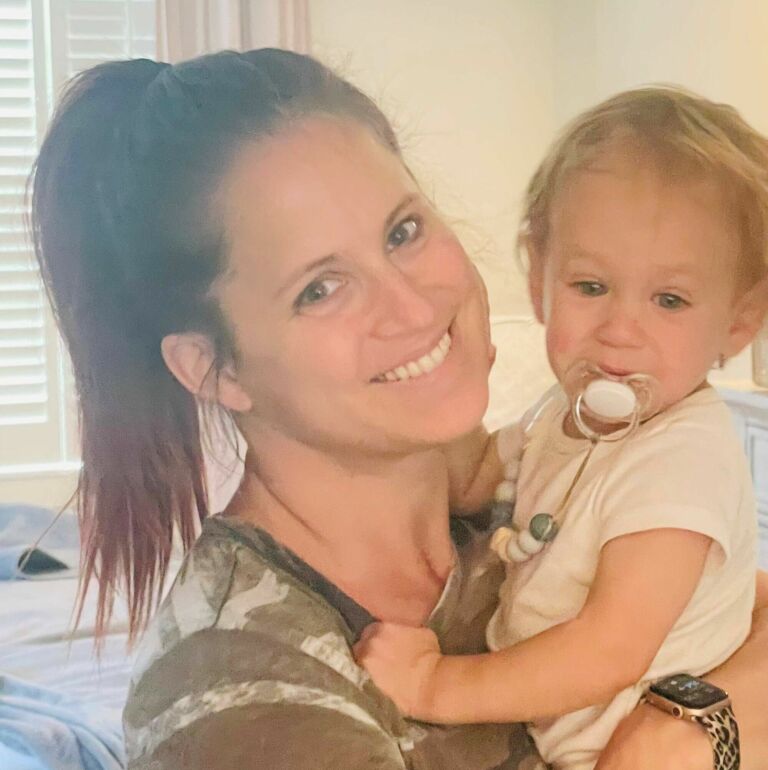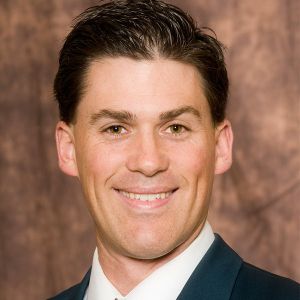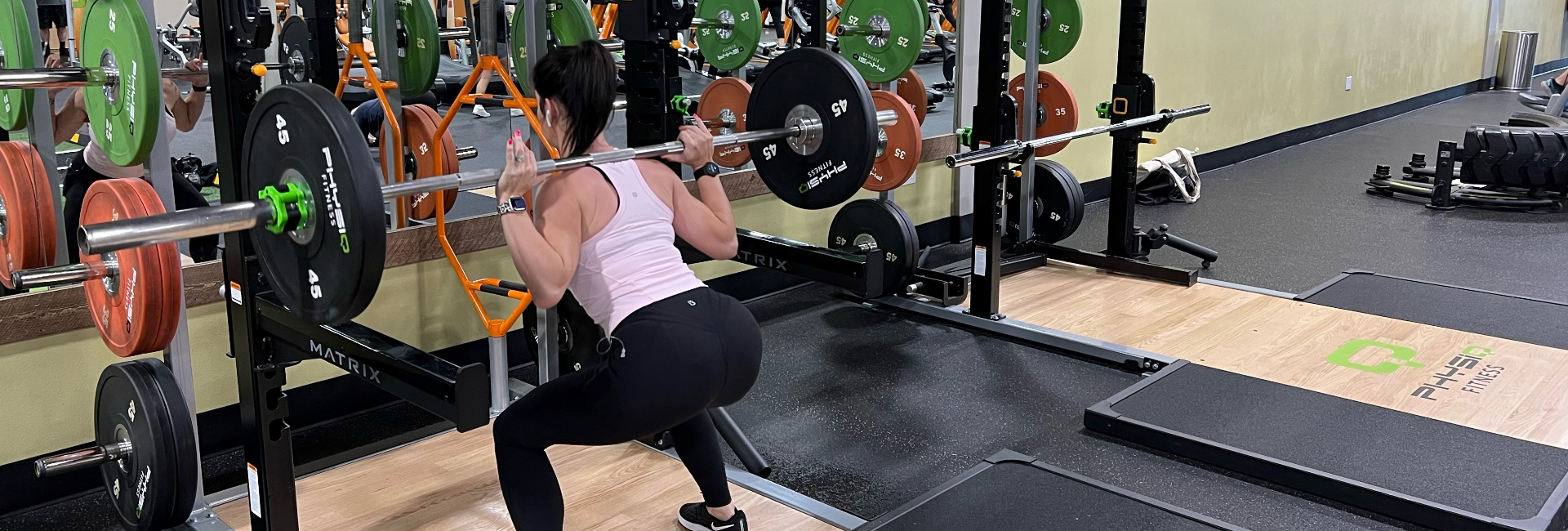#MyPTStory
When Aubrey Burningham approached her due date with her fourth child, the excitement and anticipation were profound. The young mom could not wait to meet her son, the addition who would complete her loving, active family.
Her pregnancy had been smooth, despite the life challenges the COVID-19 pandemic presented. While her baby boy was born perfectly healthy and happy, it was the delivery itself that set Aubrey on what would prove to be a long and painful journey.
“When they broke my water the hospital bed just fell apart,” Aubrey shared. “My leg crashed down.”
In that moment, Aubrey said, she didn’t think a whole lot about the mishap.
“Then the baby got stuck so they put me in some crazy maneuvers to get him out,” she added.
After such a traumatic delivery, Aubrey was not too concerned when she began to feel like things weren’t quite right with her.
“I figured I would be fine in a couple of weeks.”
At home with a 5-year-old, a 4-year-old, a 2½-year-old and a newborn, Aubrey soon found herself unable to function due to the extreme pain in her hip. As her husband watched her, he reflected on his own experience – he had a torn labrum at the time – and became convinced she had the same injury.

Aubrey set up a telehealth visit with her primary care doctor who had her stand up and take two steps on camera. She explained that she was looking for possible joint issues, which can be caused by the maneuver often used during cases of shoulder dystocia in which a baby’s shoulder gets stuck behind the mother’s pubic bone or sacrum during birth.
Next, Aubrey’s doctor sent her for an Xray, hoping for more information, hoping for answers, but the imaging was clear. Nothing, it seemed, was wrong.
As time went on Aubrey’s pain extended into her sciatica, sending nerve pain into her leg. The pain became so excruciating that she could not sit to nurse her son, nor could she carry him around to comfort him.
“I knew this was my last baby and it killed me that I could not sit and enjoy him the way I wanted to, to cuddle him … It felt like it was all being taken away from me,” she said. “I was feeling so helpless.”
Because schools were operating virtually due to Covid, Aubrey was able to hire local high schoolers to help with the baby and the other kids during the day. Though the gyms Aubrey and her husband own and operate were closed due to the pandemic, the work was harder than ever.
“My husband was on the phone all day trying to secure funding, working with lobbyists, fighting for people’s right to exercise all while creating digital content nonstop,” Aubrey explained. “All after he cared for the kids in the morning until my help could arrive.
“I simply was not functioning as a human. I was here, but I wasn’t a mom, I wasn’t a wife, I was literally just here.”
Beginning a physical therapy journey
Aubrey began working with physical therapist Kirsten Smith at Therapeutic Associates Physical Therapy – South Salem.
Kirsten, Aubrey recalled, was certain that her pain was coming from her back not her hip, and that because it seemed to be getting worse, she should have an MRI. Her doctor disagreed, citing the statistic that nearly 30 percent of the population have herniated discs, and most are fine and do not experience any pain.
“All I could say was, ‘I am NOT fine.’ But they said that even if an MRI showed a herniated disc, they wouldn’t treat it.”
Three months post-partum, Aubrey was feeling desperate.
As her physical therapist, Kirsten began advocating for Aubrey, emailing doctors and requesting they order imaging.
When she finally got an MRI, it showed a very mild herniation at L4/L5 and possibly a torn labrum. It was recommended that she try an epidural steroid injection, which she did, hoping it would provide some relief.
“I just remember walking around the house all night because there was nothing else I could do I was in so much pain. I’ve never not been tired with a newborn baby, but I was in so much pain I could not even tell how tired I was.”
Kirsten was able to show Aubrey how to lie down on her stomach with a pillow beneath her hips to put her back into an extension. This position helped with the pain, and she was able to rest for about three hours at a time.

Ultimately Aubrey had five different injections, none of which did anything for her pain. As a diabetic, she would experience elevated blood sugar for about two weeks each time, but said she felt no relief.
“Everyone was constantly telling me how mild my imaging was, that my case was so mild,” Aubrey shared, adding that she considers herself to have a high tolerance for pain and yet she was taking the maximum dose of Tylenol and Ibuprofen daily. “I was nursing so I would not take any narcotics, plus I’m afraid of them.”
Eventually, finding no relief from the pain meds, she simply stopped taking them.
A chronic pain diagnosis
Six months post-partum Aubrey was referred to a neurosurgeon who suspected she had nerve damage in her leg as a result of it falling when the hospital bed collapsed during her labor. Aubrey explained that diabetics often have more reactive nerves, which added to her neurosurgeon’s suspicions, but a nerve conduction study came back normal.
“I remember being at my sister’s house when they called me. They said, ‘At this point, we can do surgery but it’s probably not going to help, and you need to get in touch with your doctor about chronic pain management.’ I was 35 years old. I could not believe this was where I was at and for them to nonchalantly say that to me. I could not fathom that this was how I was going to be for the rest of my life.”
Neither could her husband, who decided at that point to circumnavigate insurance and pay out-of-pocket for Aubrey to see a surgeon whom, as a personal trainer, he had worked with for more than six years.
“I got in to see her about a month later and I remember her literally saying, ‘I do not know why you would not do surgery.’ She said the disc herniation was right where it would cause my exact symptoms.”
Aubrey called her primary care doctor and stated that she had received a second opinion and wanted surgery. Four months later, when her son was a year old, Aubrey was on the operating table.
Her fight, however, wasn’t over yet.
“I remember the neurosurgeon coming in and looking right at me and saying, ‘This probably is not going to work.’ He said that maybe I’d be in the 1 percent of people that this would help. I was ready to get off the table.”
Hearing, in that moment, once again, that she was likely facing a chronic pain situation was devastating and made Aubrey think about the six to eight weeks of movement restriction she would be under during post-surgery recovery – a time in which she would not be able to pick up any of her children or bend to play with them. However, at this point, even a 1 percent chance was worth it to her.
A surgical success
When Aubrey’s surgeon updated her after the surgery, she was elated. During the procedure, he had not only found a disc herniation in L4/L5, but he had also discovered that her nerve was trapped in more than one place – something that they had not been able to see on her MRI. With this, he was far more confident that the surgery had been a success and that Aubrey would recover and go on to live a pain-free, active life. He did advise her, however, that she would not be able to go back to weight training and would never do anything like squats again.

Undeterred, as soon as she was cleared, Aubrey was back in physical therapy.
“I did all my rehab, my physical therapy, I tried to follow it all by the books,” she said. “I was terrified and had to be reminded several times that pain was expected and that it takes a nerve forever to heal, leaving your body in a sort of muscle memory mode where it won’t let go of the past experience and the pain that came with it.”
The phenomenon Aubrey was experiencing, explained PT and clinic director Jeff Blanchard, was neuroplastic pain, which is a pain signal generated by the brain in the absence of current tissue trauma. Despite the lack of tissue damage, the pain is still very real.
“Pain is not a sensation, it is a complete experience – a mind-body experience – and so it is important to consider all the pieces of the puzzle when it comes to pain,” Jeff said. “For Aubrey, when her leg fell it created tissue trauma in addition to the psychological trauma and emotion of trying to deliver a baby. It triggered a cascade of events which led to a very high level of pain in her pain experience.”
The biological aspect of Aubrey’s injury as seen in her MRI, Jeff added, may not have been the main reason for the pain she was having. But, because she could not make progress with PT, he said, eventually she turned to surgery. Surgery, he explained, is a very powerful intervention.
“Your brain expects to feel better or different after surgery,” he continued. “So, surgery can have some placebo effect – which, for the better or for the worse? Usually for the better.”
For Aubrey, things did get better, slowly.
“It was difficult for a long time,” Aubrey reflected. “I would regularly start thinking, ‘Oh it’s back.’ I was constantly just waiting for the shoe to drop.”
Through her physical therapy journey, Aubrey learned to recognize that she was okay and that she could push herself without worrying that every new movement she tried would cause a flare-up and that even if it did, she would be okay.

The brain’s role in pain
As time went on, Aubrey got her life back. Her post-surgical physical therapy and ongoing self-care restored her confidence and empowered her to trust her body.
When the family set out on a summer adventure a year after Aubrey’s back surgery, things were picture-perfect. The three-week road trip kicked off with boating and wake surfing, which as a young, active woman, Aubrey was more than excited to participate in. Unfortunately, a fall while surfing sent her spiraling back into a place of fear and pain.
“I did something weird – I twisted it awkwardly, and I started to go numb in my left leg – the leg I’d never even had issues in before. Then my right leg started to hurt,” Aubrey shared. “I was terrified. I kept thinking how I could not go back to this, to not being able to pick up my son who was 2 years old by this time.”
Aubrey called her surgeon, who put her back on movement restriction, and then she set her mind to making the most of the family’s trip. They headed to Disneyland, but Aubrey, afraid of aggravating her back, spend much of the time just watching – skipping most of the rides herself.
She was not alone in her fear.
“My husband said, ‘I can’t go back to how it was.’ He had felt as helpless as I did at the time. It had truly affected every aspect of our lives.”
Without discounting the possibility that she had reinjured herself, Aubrey’s husband suggested they reach back out to Therapeutic Associates and talk to Jeff Blanchard, knowing he is educated and experienced in the psychology of pain. Aubrey agreed.
“When Aubrey came in,” Jeff reflected, “I recognized some of the hallmark signs of neuroplasticity in addition to mechanical pain. She was very open to having a conversation about it, which not everybody is.”

Jeff worked with Aubrey to increase her understanding of how pain works. They discussed the sympathetic nervous system and the parasympathetic nervous system and how many people are stuck in the sympathetic or fight-or-flight mode where the brain will take a pain signal and turn it way up.
“We talked about the proverbial pain dial that we all have inside our brains that can either go up or go down. When it’s up, any signal from your body is amplified, just like you’re turning up the stereo,” Jeff explained. “Or, if it’s down, you can have damage to the body, but the signal is not recognized as a problem and then you don’t experience pain. It can go either way.”
Aubrey’s pain dial was turned way up. The pain experience she had been through previously triggered an echo of sorts, where her nervous system was responding to the danger signals and her brain was interpreting it as pain, exasperating her fear.
“That whole year after my son’s birth had been such a traumatic time and experience for my whole family – it had not only affected me but my husband and my kids, too. So, when my brain got a signal that something was going on in that same region of my body, it was throwing alarms all over the place.”
During her assessment and exam, Aubrey said Jeff explained that he believed her reactions to some of his tests were oversensitive nerves and not anything that she had reinjured or damaged again.
“He told me he wanted me right then and there to choose to believe I was safe, to choose to be okay. He told me I was so much stronger than I thought I was,” Aubrey shared.
Jeff recommended Aubrey read the book “The Way Out” – a science-based book about managing the mind-body connection to healing.

“One of the premises of the book is that your body heals better than you think, and your brain does not always heal with it,” Aubrey shared. “You can’t believe what your brain tells you all of the time.”
As Aubrey read, the ideas in the book resonated with her, and soon what she had been experiencing as pain was gone. Jeff continued to work with her and encouraged her to push herself at the gym, not to be afraid of her symptoms, and to look for pain-free moments.
“I started to look for those moments – they’re evidence that the pain doesn’t have to be there,” Aubrey said. “I’ve learned a lot and am in a better place now that I’ve worked through pain reprocessing theory. I had never experienced anything like this. I could always handle a lot of pain, so then to be so totally overwhelmed by it and then in constant fear of it coming back … Now I have taken back control. It’s so powerful to be freed from the pain and the fear of the pain.”
It’s not, Aubrey added, that the pain is not real.
“Do you feel the pain? Yes. Then it’s real. But is the cause of it real? No.
“It’s so humbling to be faced with the fact that I was in a battle with my own brain. I still have random moments when I think about it or I am in pain, but now I know that I can remind my brain that I am safe.”
Today, not only is Aubrey able to be the playful, engaged mom she wants to be, but she’s back in the gym doing what she loves.
“My surgeon said I would never do anything like squats again,” she emphasized. “Well, I do heavy squats at least once a week if not twice a week! And it is all because of physical therapy and pain reprocessing.”
Her painstaking journey was long and riddled with obstacles, but through physical therapy Aubrey found a pathway to healing.

